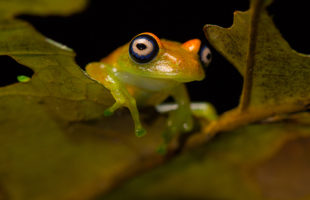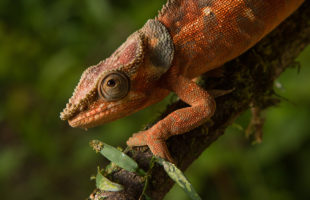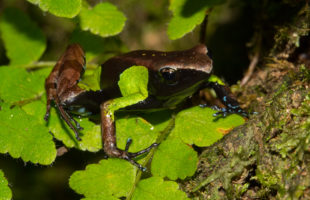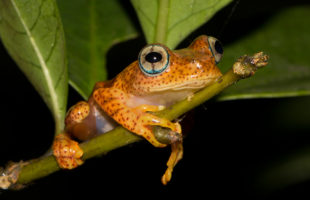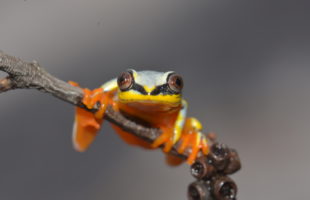Looks like a poison dart frog, but it’s not! Like their South American counterparts, frogs of the genus Mantella on Madagascar wear bright colors to draw attention to skin poisons. For humans, however, the small frogs of the island in the Indian Ocean are completely harmless. Ebenau’s colorful frog (Mantella ebenaui) doesn’t match its English name ‘Brown frog’. It wears …
LesenSchlagwort-Archiv: frogs
Master of camouflage: The Marbled Rain Frog
Madagascar is home to many frogs that are found nowhere else in the world. One such unique inhabitant of the tropical island is Scaphiophryne marmorata, the Marbled Rain Frog. The males of the Marbled Rain Frog grow to 32 to 36 millimeters in size – that’s just a little more than two sugar cubes. You can easily recognize them by …
LesenThe Green Bright-Eyed Frog
Anyone who has ever been on the road in Andasibe-Mantadia will surely have discovered it at night: Boophis viridis, the Green Bright-Eyed Frog. Most specimens have a lot of red dots on their body, which is especially noticeable at night. They only grow to 29 to 35 mm, with the females occupying the upper size places. You can easily distinguish …
LesenProtected area Maromizaha
Maromizaha: Actually this protected area consists of two forest areas, Maromizaha and Vohidrazana. The latter means as much as “mountain of the ancestors”. In contrast, the Malagasy words maro and mizaha can have two different meanings. It may be “the place where many people do research” but also “the forest which is exploited by many people”. Location: Maromizaha is located …
LesenThe sky blue reed frog
An especially pretty frog is the blue reed frog (Heterixalus madagascariensis) or Madagascar reed frog: There are yellow and sky blue variations, with yellow or orange arms, legs, hands and feet. In the sun, they often become almost white. Literature mentioned the sky blue frog for the first time in 1841: The French zoologist André Duméril and his assistant, Gabriel …
LesenDer Tomatenfrosch
1875 fiel dem französischen Naturforscher Alfred Grandidier ein knallroter, dicker Frosch auf einer seiner vielen Reisen nach Madagaskar in die Hände. Gebracht hatte ihn ein Landsmann, der sich als Händler an der Ostküste niedergelassen hatte: Ein gewisser Herr Guinet. Der weit gereiste Grandidier nahm Tiere der noch unbekannten Art mit nach Frankreich und beschrieb sie dort erstmals. Warum ihm der …
LesenGuibé’s mantella
You think poison dart frogs exist only at the Amazon? You are miles out! Madagascar has amphibians very similar to those, the Mantellas or coloured frogs. Like poison dart frogs, Mantella frogs produce a poison secreted via their skin, but it is completely harmless for human beings. Genetically, the Madagascan Mantellas are not related to poison dart frogs. Mantella frogs …
LesenAgainst the tide: A climbing Mantella
Actually, Madagascan Mantellae all look very similar: Striking colours, small and slender, terrestrial frogs. But one steps out the line: The climbing Mantella (Mantella laevigata). This Mantella was described in 1913 by British zoologists Paul Ashleyford Methuen and John Hewitt, who did a seven months lasting expedition to Madagascar two years ago. The climbing Mantella grows up to maximally 29 …
LesenThe not really fiery red frog
Madagascar’s dense, mystical rainforests offer a home to countless endemic (i.e. only here occurring) animals. Among them is a particularly colorful representative of the Madagascar frogs, a frog with the scientific name Boophis pyrrhus (from Greek pyrrhos = fire red). It can be found on the east coast and in the southern highlands of Madagascar, from Soanierana Ivongo near the …
LesenAmphibians in general
Especially the rainforests of Madagascar offer an abundance of different frogs for observation and discovery. Almost 4% of the world’s amphibian fauna is found on the island. Especially in the rainy areas on the east coast, you can find countless different species in a small area. In the rainy season, the croaking, chirping, and chirping of the courtship males can …
Lesen MADAMAGAZINE Your Magazine about Madagascar
MADAMAGAZINE Your Magazine about Madagascar



